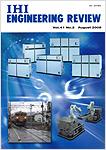3-D Laser Radar Level Crossing Obstacle Detection System

3-D Laser Radar Level Crossing Obstacle Detection System
- HISAMITSU Yutaka, SEKIMOTO Kiyohide, NAGATA Kouichirou, UEHARA Minoru, OTA Eiichi
Level crossing obstacle detection systems have been developed to prevent a train colliding with an object such as a vehicle stuck on the crossing. Increasing safety consciousness, however, has prompted railway companies to install more advanced systems than those that have been used conventionally. To cope with the demand for new devices, IHI developed a 3-D laser radar level crossing obstacle detection system which is not influenced by weather conditions or sunshine conditions, and which can accurately detect objects within the area of the level crossing in real time. Reliable detection can be achieved by installing just a single monitor that can cover the whole area of the crossing, thus surpassing the conventional system in sensing the obstacles in the crossing.



